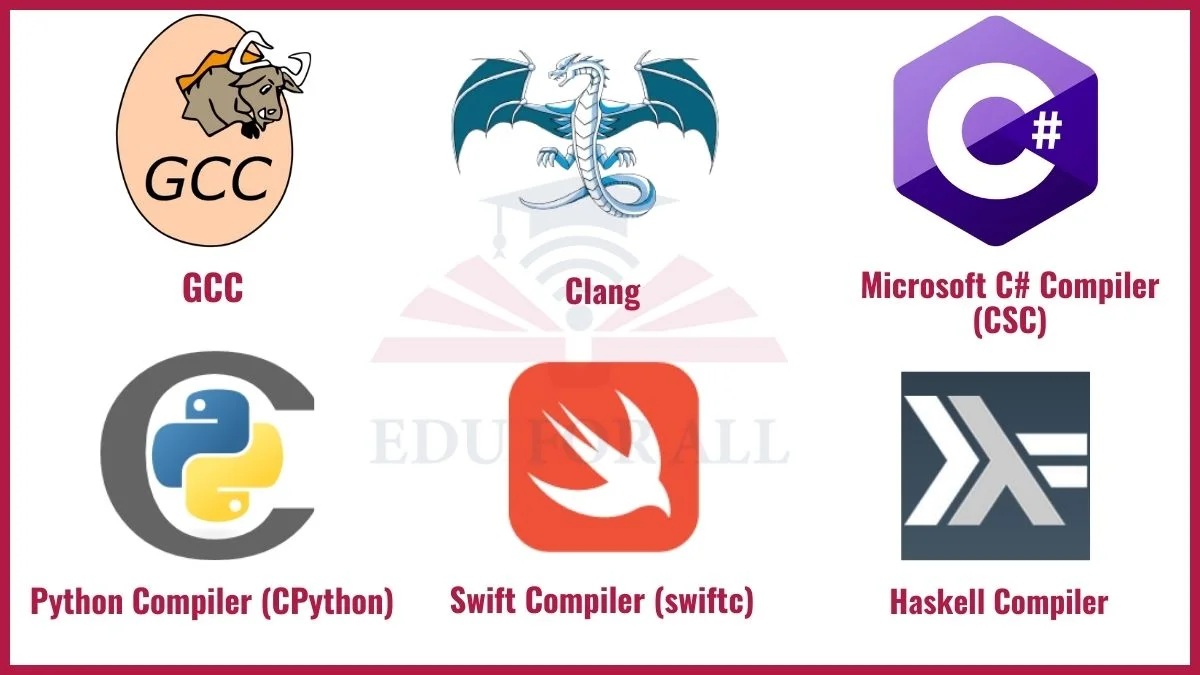A compiler in programming languages is a special software tool that translates human-readable source code written in a programming language into machine-readable code or executable code.
Examples of compilers include GCC, Clang, Java compiler, Python compiler (CPython), Go compiler (gc), and more.
Examples of Compilers
Here are the best examples of compilers:

1. GCC (GNU Compiler Collection)
GCC is a big helper for programmers. It can understand different languages like C, C++, and Fortran. People like it because it’s free and can work on many types of computers. It’s like a toolbox that helps programmers build their programs better and faster.
GCC has been a crucial part of many Unix-like systems and is known for its support across different hardware architectures.
2. Clang
Clang is a cool tool made by Apple. It helps with C, C++, and Objective-C languages. People like it because it works fast and tells them about mistakes. It’s like a superhero for programmers, helping them with their projects.
Clang is the default compiler for Xcode. Clang is the favorite tool for making apps on Apple devices.
3. Java Compiler (javac)
The Java Compiler, or javac is part of the Java Development Kit (JDK). It changes Java code into something called bytecode. Bytecode can run on any computer with something called the Java Virtual Machine (JVM). It’s like magic because Java programs can run on different computers without any changes.
Java is one of the most widely used programming languages and many big applications are made with it.
4. Microsoft C# Compiler (CSC)
The C# compiler is called CSC. It takes C# code and makes it into something called MSIL. Then, a special place called the Common Language Runtime (CLR) helps run the code. It’s like a team effort, making sure C# works well with other languages.
C# is a key language for Windows development, widely used for building desktop and web applications.
5. Python Compiler (CPython)
CPython is the main helper for Python. Even though people say Python is easy and doesn’t need compiling, CPython still does some magic. It changes Python code into something called bytecode, which makes Python programs run faster. It’s like a behind-the-scenes helper.
Python is known for its readability and simplicity. It is used in many areas, like websites and data science.
6. Rust Compiler (rustic)
Rust’s helper rustc, is like a superhero making sure things are safe and fast. It’s strict and prevents common mistakes. Rust wants to be fast like C and C++. It is also safe like Python. The rustc compiler is the key to making this happen.
Rust is becoming famous for making reliable and fast software.
7. Haskell Compiler (GHC – Glasgow Haskell Compiler)
GHC is the main worker for Haskell. Haskell is a bit like math and has strong rules. GHC takes Haskell code and turns it into machine code. It’s like a magician doing tricks with numbers. Haskell and GHC together make smart and fast programs.
Haskell is used a lot in universities and for smart programming tasks.
8. Go Compiler (gc)
The Go language has its helper which is called gc. Go is simple and fast and GC helps keep it that way. It quickly changes the Go code into a form that computers understand. Go is often used for building things in the cloud, and GC is the secret helper making it happen.
Go is liked for its simplicity and is popular for cloud programming.
9. Fortran Compiler (GFortran)
GFortran is like a special worker for Fortran. It is an old but still useful language. Fortran is good with math and science stuff. GFortran helps Fortran code run fast. It’s like having a powerful calculator for scientists and engineers.
Fortran is still used a lot in high-performance computing due to its efficient handling of numerical computations.
10. Swift Compiler (swiftc)
Swift is made by Apple and has its superhero “swiftc”. It changes Swift code into something computers understand. Swift is used for making apps on Apple devices, and swiftc is the reason those apps run so fast and smoothly.
Swift is the go-to language for making cool apps on iPhones and Macs.
Also Read:

